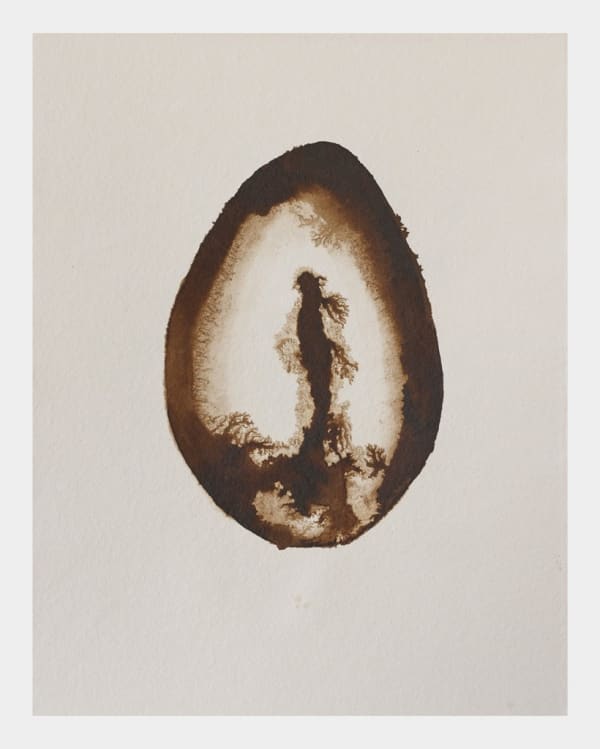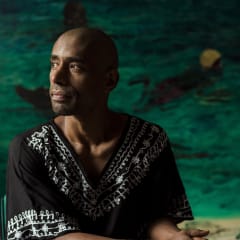Pele de Dentro Antonio Obá
May 1 - Jun 22, 2018
The works that Antonio Obá has been developing over the years, a selection of which are in this exhibition, pass through various languages of the visual arts, such as his exquisite drawings that point out the exquisite mastery of line, shadow and composition; the arrangements we can understand as assemblages or objects; installations whose atmospheres incorporate sacredness; and finally his sweeping performances utilizing his own body.
Always well executed formally, his works are the result of thorough research, relentless artistic practice and the revisiting of his ancestry. His arrested thoughts about the body occupy his being and his processes of unveiling and revealing, of reconciling himself with his own lineages. His poetics denote an immersion within his interior self, evoking other beings from the visible and invisible world; which constitute him as a human being, living being, animal being.
At first glance, we encounter the sacred in Antonio Obá’s works, in the more everyday sense, as he activates Judeo-Christian liturgical iconography. However, as we approach other works, we are encountered with the layers of Africanism, more precisely situated between the spiritual and cultural heritages of the Iorubá and Bacongo peoples, who are revealed through a narrative impregnated with meaning for Afro-Brazilians, dialoguing with the memory of the painful crossing of the Atlantic Ocean.
These layers are also revealed by the adopted name of the artist. Antonio, references Santo Antonio (Saint Anthony), not after Saint Anthony of Pádua, but Saint Anthony of Categeró, born in Northern Africa in the 15thcentury. A black enslaved man, he was taken to Sicily, where he dedicated himself to protecting the poor.
The name ‘Obá,’ represents the duality of the masculine and feminine genders. ‘Obá’ was the word for ‘King’ in the Benin Empire of West Africa, founded in the 15th century and destroyed by the British at the end of the 19th century. ‘Obá’ is also connected to the word ‘iabá’, which is the name used for orishas (deities) with female attributes. In nature iaba is identified as the ruler of troubled waters and also as the Iaba River, also known as the Niger River. ‘Obá’ also references the Great Warrior Queen, Xangô's first wife, an Orisha who rules over thunder and fights with an ‘ofá’ (bow and arrow), sword, and shield.
Thus, Antonio Obá carries names imbued with noble attributes, which together converge in a celebrated religious syncretism. However, this fusion or new interpretation of religious and spiritual practices, denounces the violence of the processes of colonization in Brazil; a mestizo country which is the product of the violation of indigenous and enslaved black women by Portuguese colonizers.
The Brazilian population has an inner diversity and an extreme multiplicity of colors and cultures, unnamed religions and spiritual rituals are practiced, and are marked in the routines of daily chores and family customs. They are the continuation of knowledge which carry touches, lines, smells, tastes, and colors, of customs whose origins are now impossible to trace. The habits of these intimate traditions hide identities, forms of existence that unite the human and the natural being, while not cartographically separating them from the formidable mystery of existence.
Obá’s recent paintings present black men who resemble the artist, but they transcend man and the notion of realism based on the canons of mimesis, the classical tradition. In them, Obá reconnects to his ancestry and revisits his animals, animals that survive in us despite the civil excesses of postmodernity, standardization, and normativity.
Obá’s paintings utilize tones of faded yellow, pink, blue, and green taken from the facades of rural homes. These homes are lined with a mixture of water, lime and chalk powder, a type of popular dye. Discolored over time, the homes become less uniform in color which attaches them to a historical linearity, to color collectivities and individualities with various tones of being.
The representation of black bodies are entangled in white lines, lace over a brown almost black skin. Over black bodies are the búzios (cowrie shells) of divination games, which also served as coins[1], when occupying the place of the eyes they act as reminders to always see the past. The black bodies with búzios also reference sambaquis[2], accumulated layers of bodies at rest, matter in arrest, bodies that say farewell to this world, bodies that remind us of those who arrived in ships centuries ago.
Drawings, objects, installations, performances and paintings that invite us into the artists intimacy, in a resumption of a feeling, almost instinct, but denser than rationality that allows us to comprehend, which is not exactly about ‘understanding.’
Antônio Obá challenges us to move away from the notion of urban centralities as points where everything happens at an accelerated rhythm towards investigating the re-emergence of our interior. In this encounter, we recognize ourselves in other rhythms, in other beings, in other affectivities, in other intensities, in a communion with the ancestry that composes us, that inhabits us and constitutes us.
If, like black bodies in the world, we often still find ourselves lost and out of place, the works of Antônio Obá announce that the first place to be reconquered is the one that we carry inside us that brings us comfort, performing a game in reverse, in which the reverse is the beginning.














